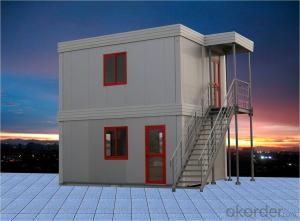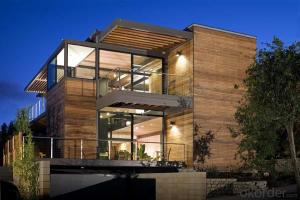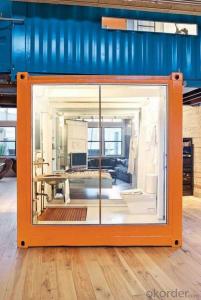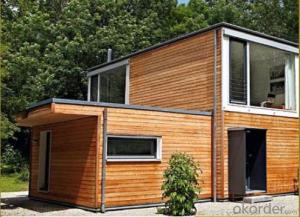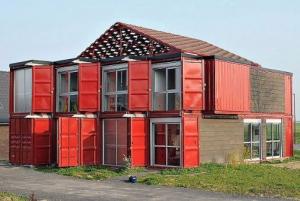Double Storey Prefabricated Container House for Accommodation
- Loading Port:
- Tianjin
- Payment Terms:
- TT OR LC
- Min Order Qty:
- -
- Supply Capability:
- 20000 Set set/month
OKorder Service Pledge
OKorder Financial Service
You Might Also Like
Double Storey Prefabricated Container House for Accommodation
1.Quick Installed Double Storey Prefabricated Container House of Hotel Building
2.Sandwich panel and Quick Installed Prefabricated Container Mobile House
3.Cheap Price but High Quality Two Storey Prefabricated Container Mobile House
4.Affordable Prefabricated Container Mobile House
1.Advantages of flatpack container house Features:
Efficient transportation
Fast construction
Flexible combination
Cost saving
Green & Sustainability
Quick Installed Double Storey Prefabricated Container House of Hotel Building
Sandwich panel and Quick Installed Prefabricated Container Mobile House
Cheap Price but High Quality Two Storey Prefabricated Container Mobile House
Affordable Prefabricated Container Mobile House
2. General information:
| Item | Description |
| Name | prefab shipping container homes |
| Structure |
|
| Wall Panel |
|
| Insulation |
|
| Electrical |
|
| Door |
|
| Window |
|
| | |
- Q:Can container houses be designed with multiple floors?
- Indeed, it is feasible to create container houses with multiple floors. Although containers are primarily intended to be stacked horizontally, it is conceivable to adapt and stack them vertically in order to construct container houses with multiple stories. This can be accomplished by strengthening the containers and incorporating supplementary structural supports to guarantee stability and safety. Utilizing this method of stacking containers enables the creation of multiple levels within the house, expanding the available living space and facilitating various room layouts. Nevertheless, it is crucial to collaborate with a proficient architect or engineer who possesses expertise in designing multi-story container houses to ensure the appropriate structural soundness and adherence to building codes and regulations.
- Q:Can container houses be designed with a rooftop bar?
- Certainly, rooftop bars can indeed be incorporated into the design of container houses. These houses are incredibly adaptable and can be tailored to meet specific design needs. By carefully considering and engineering the structure, it is possible to integrate a rooftop bar into a container house's layout. The container can be adjusted and reinforced to bear the weight of the rooftop bar, while extra structural components can be added to ensure safety and stability. Additionally, the rooftop area can be fashioned to accommodate seating, a bar counter, and other amenities commonly found in bars. Through clever use of the rooftop space, container houses can optimize their functionality and create distinctive and inventive living environments.
- Q:Can container houses be designed with a rustic or industrial look?
- Yes, container houses can definitely be designed with a rustic or industrial look. The modular nature of container homes allows for endless possibilities when it comes to exterior and interior design. With the right materials, finishes, and design elements, container houses can easily achieve the rustic or industrial aesthetic. For a rustic look, natural materials such as reclaimed wood or stone can be incorporated into the design. Exposed beams, distressed finishes, and earthy color palettes can also contribute to the rustic charm. Additionally, incorporating elements like barn doors, vintage lighting fixtures, and antique furniture can enhance the overall rustic feel of the container house. On the other hand, an industrial look can be achieved by using materials like metal, concrete, and glass. Exposed steel beams, corrugated metal siding, and concrete walls can create an industrial vibe. Incorporating minimalist design elements, such as clean lines, open spaces, and functional furniture, will further enhance the industrial aesthetic. It's important to note that while container houses can be designed with a rustic or industrial look, the final outcome will depend on the creativity and vision of the designer. With the right combination of materials, finishes, and design choices, container houses can successfully embrace the desired aesthetic.
- Q:Can container houses be designed with a home gym?
- Yes, container houses can be designed with a home gym. With proper planning and design, container houses can incorporate dedicated spaces for exercise equipment, such as treadmills, weights, and yoga mats. The compact and modular nature of container houses allows for creative use of space, ensuring that a home gym can be included within the overall layout.
- Q:Can container houses be designed with a green roof?
- Certainly, it is possible to incorporate green roofs into container houses. Green roofs, also referred to as living roofs or vegetated roofs, consist of vegetation, plants, and sometimes small trees covering the roof. These roofs offer numerous environmental advantages, including the reduction of stormwater runoff, improvement in air quality, and insulation for the building. Container houses, constructed from shipping containers, can be easily adapted to feature green roofs. The containers' structure provides a sturdy foundation for the installation of a green roof. The containers can be modified to create a flat roof surface, which is ideal for green roof installations. To design a container house with a green roof, certain factors must be taken into consideration. The weight of the green roof and its impact on the container structure must be accurately assessed to ensure the roof can be safely supported. Adequate waterproofing and drainage systems should also be implemented to prevent leaks and ensure effective water management. In addition to the environmental benefits, green roofs on container houses can enhance the building's aesthetic appeal. They create a beautiful and natural appearance, seamlessly blending the house with its surroundings. Moreover, green roofs can provide additional outdoor space for residents to enjoy, such as rooftop gardens or relaxation areas. In conclusion, container houses can undoubtedly be designed with green roofs, offering an environmentally friendly and visually appealing option for sustainable housing.
- Q:Can container houses be built in remote locations?
- Yes, container houses can be built in remote locations. In fact, their modular nature and ease of transportation make them an ideal choice for remote areas. Container houses can be easily transported to remote locations via trucks, ships, or even helicopters, depending on the accessibility of the area. Additionally, container houses are designed to be self-contained units, which means they can be built with their own water, sewage, and power systems, making them suitable for areas without existing infrastructure. Moreover, containers are known for their durability and ability to withstand extreme weather conditions, making them a practical option for remote locations that may experience harsh climates. Overall, container houses offer flexibility, convenience, and cost-effectiveness, making them a viable solution for housing needs in remote areas.
- Q:Are container houses suitable for temporary or permanent living?
- Container houses are suitable for both temporary and permanent living. They provide a cost-effective and sustainable housing solution, making them ideal for temporary accommodations like disaster relief shelters or construction site offices. Additionally, with proper insulation and interior design, container houses can offer comfort and functionality for long-term living, making them a viable option for permanent dwellings as well.
- Q:How do container houses handle plumbing and sanitation?
- Container houses handle plumbing and sanitation in a similar way to traditional houses, but with a few modifications due to the unique nature of the structure. To begin with, container houses typically have a water supply system that connects to the local water source. This can be achieved by either hooking up to the municipal water supply or by installing a well or rainwater harvesting system. The water supply is then distributed throughout the house using pipes and fixtures just like in a regular home. As for wastewater management, container houses have a sewer system in place. This involves the installation of plumbing pipes to carry wastewater from sinks, showers, and toilets to a septic tank or a municipal sewer line. The plumbing system is carefully designed to ensure proper drainage and prevent any leakage or odors. Additionally, container houses often include a greywater system, which collects and treats wastewater from non-toilet fixtures such as sinks and showers. This treated water can then be reused for irrigation or flushing toilets, reducing water consumption and promoting sustainability. When it comes to sanitation, container houses have bathrooms equipped with standard fixtures, including toilets, sinks, and showers. These fixtures are connected to the plumbing system and operate just like those in a conventional home. It is essential to ensure proper ventilation and waterproofing to prevent any issues related to moisture buildup or mold growth. In summary, container houses handle plumbing and sanitation by connecting to a water supply, featuring a sewer system for wastewater management, and incorporating standard fixtures for hygiene purposes. While there may be some modifications required to fit the unique structure, container houses can offer the same level of functionality and convenience as traditional homes.
- Q:Can container houses be transported overseas?
- Yes, container houses can be transported overseas. The design and structure of container houses make them suitable for international shipping. They can be easily loaded onto cargo ships and transported to different countries.
- Q:What are the different types of container house foundations?
- There are several different types of foundations that can be used for container houses, depending on various factors such as soil conditions, local building codes, and personal preferences. 1. Concrete Slab Foundation: This is one of the most common types of foundations used for container houses. A concrete slab is poured directly onto the ground, providing a stable and level surface for the containers to sit on. It requires excavation, proper site preparation, and reinforcement with steel bars or mesh. 2. Pier Foundation: Also known as a post foundation, this type involves supporting the containers on a series of concrete piers or posts. These piers are strategically placed under the corners and midpoints of the containers to distribute the weight evenly. It is a cost-effective option, especially for sites with uneven terrain or poor soil conditions. 3. Strip Foundation: A strip foundation consists of a continuous concrete strip that runs along the perimeter of the containers. It provides a stable base for the containers and helps distribute the weight evenly. This type of foundation requires more excavation and site preparation compared to other options. 4. Screw Pile Foundation: Screw piles are long metal screws that are driven into the ground using hydraulic machinery. They provide a strong and stable foundation for container houses and can be used in various soil conditions. This type of foundation is quick to install, requires minimal excavation, and can be easily adjusted or removed if needed. 5. Raft Foundation: A raft foundation, also known as a mat foundation, involves laying a large concrete slab directly on the ground. The entire footprint of the container house is supported by this slab, providing a solid and level foundation. This type of foundation is suitable for areas with poor soil conditions or areas prone to earthquakes as it distributes the load over a larger area. It is important to consult with a structural engineer or a professional builder to determine the most suitable foundation type for your container house, considering factors such as soil reports, local regulations, and budget constraints.
1. Manufacturer Overview |
|
|---|---|
| Location | |
| Year Established | |
| Annual Output Value | |
| Main Markets | |
| Company Certifications | |
2. Manufacturer Certificates |
|
|---|---|
| a) Certification Name | |
| Range | |
| Reference | |
| Validity Period | |
3. Manufacturer Capability |
|
|---|---|
| a)Trade Capacity | |
| Nearest Port | |
| Export Percentage | |
| No.of Employees in Trade Department | |
| Language Spoken: | |
| b)Factory Information | |
| Factory Size: | |
| No. of Production Lines | |
| Contract Manufacturing | |
| Product Price Range | |
Send your message to us
Double Storey Prefabricated Container House for Accommodation
- Loading Port:
- Tianjin
- Payment Terms:
- TT OR LC
- Min Order Qty:
- -
- Supply Capability:
- 20000 Set set/month
OKorder Service Pledge
OKorder Financial Service
Similar products
New products
Hot products
Related keywords
